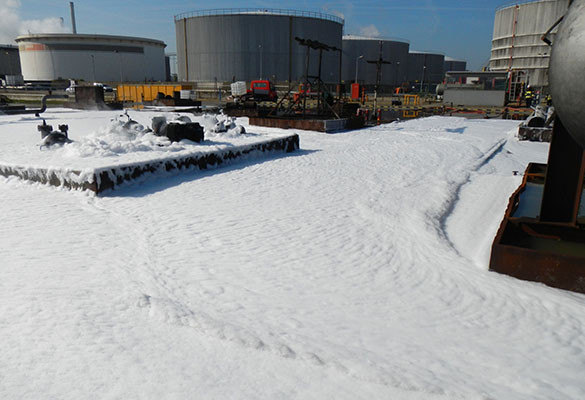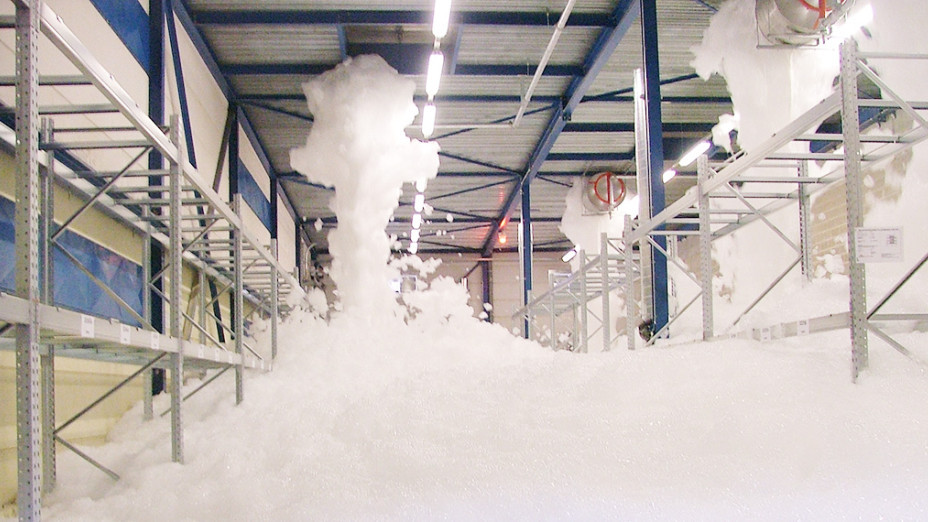Extinguishing foam can be used for multiple purposes. Repressive: for extinguishing and controlling (large) fires. And preventative: for covering flammable (liquid) substances.
The effect of extinguishing foam is based on one or more of the following principles:
- Cooling. The temperature of the combustible material is reduced when using e.g. heavy foam, by the large water content in the foam;
- Covering. The closed foam layer stops further evaporation of combustible material;
- Isolate. Due to the low thermal conductivity of the foam, foam-covered materials will not be (re)ignited by heat;
- Displacement. By filling spaces, e.g. sewers / parts of installations with medium or light foam, the oxygen and combustible gases required for combustion are displaced.
Types of extinguishing foam
Extinguishing foam is a mixture of water, foam concentrate and air. Extinguishing foam is obtained by mixing water and foam concentrate in a foam proportioner (the so-called premix) and expanding it in a foam maker by adding air or gas. The mixing ratio of the foam concentrate can vary, depending on the type of foam concentrate, from 0.5% to 6%. The amount of foam that is obtained by expanding the premix is also referred to as expansion growth. We differentiate 3 types of extinguishing foam, depending on the expansion:
- Heavy foam: expansion to 20. Used to bridge large distances in the event of tank fires and aircraft fires;
- Medium foam: expansion capacity 20-200. Used to fill spaces such as sewers, tunnel shafts, bund areas and waste bunkers;
- Light foam: expansion capacity >200. Used as large enclosed spaces such as aircraft hangars, PGS rooms and storage halls that have to be filled quickly.

Application areas
Foam concentrates are available for extinguishing or covering non-polar substances, such as hydrocarbons and polar substances, such as alcohols.
The figures listed with the foam concentrate indicate the mixing percentage, e.g. AFFF 3% means that 3% must be mixed in. An alcohol-resistant foam can often be applied to both non-polar and polar substances and can be referred to as AFFF-AR 1/3. Which means that the foam concentrate must be mixed in at 1% when used for non-polar substances and at 3% for polar substances.
The quality of a foam concentrate is indicated, according to the EN 1568 (European standard), by an achieved rating: a number and a letter. An 1 + A rating is the highest attainable rating that a foam concentrate can achieve. That means this foam concentrate can quickly control a fire and ensure, through rapid extinguishing, less harmful substances are released into the environment.
If a foam concentrate can be used with both freshwater and seawater then this is indicated on the label of the packaging or on the data sheet by indicating a double rating, e.g. 1A/1B. Where in this example rating 1A was achieved when applying with fresh water and rating 1B is achieved when applied with salt water.
In addition to the quality rating, the application rate of extinguishing foam is also important when fighting large liquid fires. This is the minimum amount of water/premix that must be applied to a liquid fire per liter/m2/minutes in order to effectively extinguish a fire. These recommended minimum application rates are stated in the NFPA 11 (American guideline for the application of fire-extinguishing foam).
